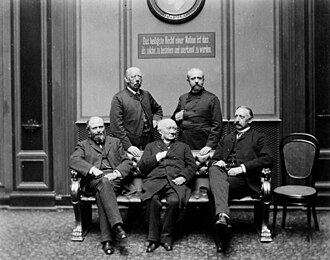German-Hanover party
The German-Hanoverian Party ( DHP ), also "Guelph" called, was a conservative - federalist party in Prussia and in the German Reich .
Prussia and the Empire
The party was founded in 1869 to protest against the annexation of the Kingdom of Hanover by Prussia and the confiscation of the Welfen property ( Welfenfonds ). It sought the restoration of the Guelph dynasty and was therefore also called the "Guelph Party". The conservative, Lutheran party was anti-Prussian and, above all, strongly anchored in East Hanover. There were numerous aristocrats among the leading politicians . In the Reichstag of the Empire , the deputies of the Party included regularly as guest students the fraction of the center of. Her Reichstag member Ludwig Brüel , a close friend of the center leader Ludwig Windthorst , played a key role in the negotiations on the return of the Welf Fund in 1892. The party leader (= chairman of the board of directors of the Hanoverian electoral association, as it is called) was Georg von dercken (1836–1898), MdR 1890–1898 , from 1890 to 1898 . The party was represented in each Reichstag with a strongly fluctuating number of mandates (between two and eleven), but this is due to the electoral law in effect in the Empire , which provided for a runoff election if no candidate achieved an absolute majority in the first ballot. As a result of voting agreements between the parties for the runoff election, a discrepancy between the proportion of votes and the proportion of mandates could arise. In percentage terms, voter support fell from 1.9 in 1871 to 0.7 in the 1912 elections.
Weimar Republic
After 1918, the DHP campaigned for Hanover to be independent of Prussia as a member state of the German Empire . A preliminary vote carried out for this in 1924 failed. a. due to strong state pressure on officials, the press, etc. The party then began to decline, with the Protestant "Welfen" in East Hanover going to the DNVP and the NSDAP , the Catholic "Welfen" in the Osnabrück area and the Emsland in part, like the member of the state parliament Wilhelm Borgmann from Lorup in Emsland to the center. While in the early years of the Weimar Republic the party still had absolute or even two-thirds majorities in the Reichstag elections in individual districts, the number of votes fell significantly by the end of the 1920s and in 1932 sank for the first time below the 60,000 necessary to win a Reichstag mandate .
In 1933 the DHP disbanded in order to forestall the ban by the National Socialists.
Federal Republic of Germany
After 1945, the "Lower Saxony State Party" (renamed " German Party " in 1947 ) succeeded the DHP. Strongly anchored in Lower Saxony , it was the prime minister here with its chairman Heinrich Hellwege from 1955 to 1959. At the federal level, it formed a coalition with the CDU and was represented by ministers in the federal government.
In 1953, some DP dissidents founded a new DHP, but it was unsuccessful. In 1962 it rejoined the "rest of the DP", a wing that did not participate in the GDP . The only chairman of this small party was Hans Wilhelm Griemsmann . This DHP took part in the Lower Saxony state elections in 1955 and received 0.3% of the valid votes. In 1957 , together with the Center, it presented the Lower Saxony state list of the Federal Union (FU). Her member Hermann Predöhl was elected to the federal board of the FU within the framework of the electoral alliance.
German-Hanover People's Calendar
From 1898 to 1933 the party was the publisher of the German-Hanoverian people's calendar .
literature
- Heinrich Langwerth von Simmern : The German-Hanoverian party and the right-wing principle , 1882.
- Heinrich Langwerth von Simmern: The German-Hanoverian Party and the Brunswick Question , 1885.
- Hans-Georg Aschoff : The Welf Movement and the German-Hanoverian Party between 1866 and 1914 , in: Niedersächsisches Jahrbuch für Landesgeschichte Vol. 3, Hildesheim 1981, pp. 41-64.
- Hans-Georg Aschoff: Welfish Movement and Political Catholicism 1866–1918. The German-Hanoverian party and the center in the province of Hanover during the German Empire (= contributions to the history of parliamentarism and political parties, vol. 83), Düsseldorf 1987.
- Hans-Georg Aschoff: The German Hanoverian party between revolution and seizure of power (1918–1933) , in: Stader Jahrbuch 1988, Stade 1988, pp. 61–87.
- Helmut Lensing : The German-Hannoversche Party in the county of Bentheim , in: Study Society for Emsländische Regionalgeschichte (Ed.), Emsländische Geschichte Vol. 10, Haselünne 2003, pp. 246–291.
- Klaus Neumann: Political Regionalism and State Reorganization in the Early Years of the Weimar Republic in Northwest Germany , Lit. Verlag, Münster 1988
- Hans Prilop : The preliminary vote in Hanover 1924. Investigations into the prehistory and history of the German-Hanoverian party in the Prussian-German Empire and in the Weimar Republic. Diss. Phil. Hamburg 1954.
Web links
Individual evidence
- ↑ z. B. 1920 Bremervörde district 72.5%, Zeven district 71.6%
- ↑ German National Library : d-nb.info/012648973
